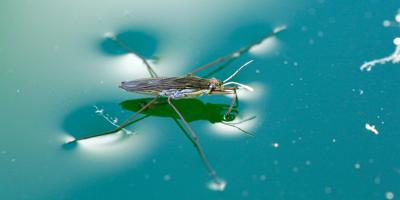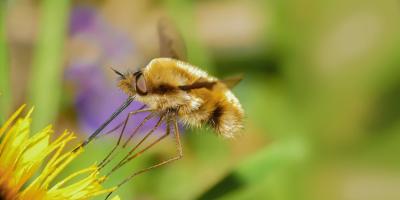No Scarcity of Stripes

The various sounds of summer insects often bring us back to the dog days of our childhood summers; from cicadas chirping in the afternoon heat to the chorus of katydids and crickets at dusk. Meanwhile, the familiar buzzing of a nearby wasp carries very different memories, accompanied by startling encounters and painful welts. While wasps and bees are always common sights during the warmer months, 2020 has brought a superabundance of them. Some New England locals have even caught sight of some particularly large wasps, though there is not currently any data to explain why they may be larger this season. They came out in greater numbers than we’ve seen in nearly a decade, and they ascended earlier than they normally do. So, what gives?
Simply put: The weather is to blame. This year, the mild winter and dry spring months allowed for more queens to survive the off-season and start new colonies much earlier.
The Top Offenders: From Greatest to Least Concern
The good news? The pollinators also managed to survive the winter better; and their current populations reflect that. The question is, with all the black and yellow flying around our yards, how do we know which ones are friends and which are foes?
That’s one question that we can answer with a simple guide to each of the most common local stinging insects, and their relative significance to homeowners:

1. Yellowjackets
First on the list is the single most common, as well as most aggressive wasp in New England: the Eastern yellowjacket. Most people associate yellowjackets with their bright black and yellow patterns and love of sugary soda and sweet watermelon. The good news is that, despite popular belief, yellowjackets are actually slow to sting when they’re on the sugar hunt. It is only when they feel that their colony or nest is threatened that they become territorial, at which point they will become very aggressive. Yellowjackets are social insects, sometimes living in colonies of up to 4,000 or more members; and when they feel that their colony or their nest is under attack, they will often defend as a group with a very effective aerial defense.
Unfortunately, it’s incredibly easy for yellowjackets to mistake you as a threat. Yellowjackets are not picky about where they nest, meaning that they could be underground, under the porch or in the eaves. So just by walking from your front porch to the mailbox, there are numerous opportunities to unknowingly walk right by a yellowjackets nest and pay dearly for trespassing.
Meanwhile, as tempting as it may be to take matters into your own hands, the worst thing you can do is to try to kill the wasps (or their nest) yourself. This is because when yellowjackets are killed, they release a pheromone that alerts the rest of their colony of the incident, and triggers them to attack their oppressor. This is why it is important to alert a pest control professional as soon as you suspect that there are yellowjackets nesting on your property, so that they can be safely and effectively handled.

2. Paper Wasps
If you’ve ever witnessed a large, and admirably crafted wasps nest hanging from a tree branch or under your eaves, it was likely built by paper wasps. Visually, these wasps are often mistaken for yellowjackets due to their similar, bright yellow and black patterns; however, paper wasps have thinner bodies compared to the protruding “Shakira” hips that the yellowjackets shake. Another telltale is their orange antennae, compared to the black antennae of yellowjackets.
The important reason to know the difference is that, while yellow jackets are known to be more aggressive, paper wasps have a much more painful sting. According to the Schmidt sting pain index, the paper wasp sting feels similar to “a single drop of superheated frying oil landing on your arm.” It was the only New England wasp to make the chart, as it carries the most painful sting of all wasps local to our region.

3. Carpenter Bees
Eastern carpenter bees are one of the most beneficial bees to the local ecosystem, but also the most damaging to man-made structures. Commonly mistaken for bumblebees, carpenter bees similarly have fluffy, muted yellow thoraxes; but what really sets them apart visually is their shiny, hairless black abdomens (the “butt” of the bee, if you will). Carpenter bees are incredibly important pollinators, but get a bad rap by their unfortunate nesting protocol.
Named for this one annoying habit, carpenter bees drill into wood to lay their eggs, often leaving unfinished decks and porches victim to extensive damage: usually about a half inch in diameter and burrowing as far as four feet from the point of entry. One bee can dig an inch into the wood in just five days, so it is crucial to be vigilant against these bees if any part of your home is constructed with untreated wood.
Luckily, female carpenter bees are not nearly as territorial as other wasp species, even around their nests. Males are a different story, and have been known to act aggressively towards people that get too close. However, the key word here is “act”: Male carpenter bees do not have a stinger, and therefore cannot do anything to actively defend themselves or their nests. Ironically, only the docile females have stingers, which rarely get used unless handled or if they find a finger poking into their burrows.
Because carpenter bees are beneficial insects that are of little direct threat to people, there is no reason to bother them unless you see evidence that they are drilling holes into your home. At this point, it is important to have a trusted professional treat the wood to ensure that the damage stops there, and encourage the bees to build their nests elsewhere.

4. Cicada Killers
Measuring in at two inches in length, cicada killers are the largest wasp species in New England. However, despite their threatening name and considerable size, these wasps are extremely docile towards humans and are rarely considered nuisances.
As can be reasonably assumed, cicada killers get their name due to the fact that they actively hunt cicadas. Cicadas are common bugs that are more often heard not seen; on the hottest summer days when you can hear a chorus in the trees coming from what sounds like thousands of invisible creatures, it’s a safe bet that cicadas are to thank for the alien-like concert. And while this is typically a sound that many people enjoy hearing, cicadas are not necessarily bugs that you want overpopulating on your turf, as they can cause damage to young trees.
Meanwhile, cicadas’ large bodies make for ideal incubators for cicada killer wasps’ eggs, as well as their larvae’s first few meals. After mating, a female wasp will dig a small hole for each of her eggs, then catch and paralyze one cicada at a time with her powerful stinger before dragging one into each nest. Once it’s safely in place, she’ll inject one egg into each cicada before finally locking it inside its own underground den. The cicada from that point serves as a live incubator until the wasp egg hatches 2-3 days later. From there, the incubator bug evolves into a living buffet for the larva until the wasp is strong enough to dig itself out of the nest as a mature adult.
While cicada killers undeniably appear threatening, they cause little trouble to humans. Like carpenter bees, females are not territorial and males are not equipped with stingers, so they rarely sting anything besides cicadas. Some biologists even argue that they are beneficial to the ecosystem, as large numbers of cicadas can be harmful to young trees, and these wasps help keep their populations down.

5. Asian Giant Hornets
Coming in last place on the list of wasps of concern is the Asian giant hornet, recently nicknamed “Murder Hornet” for its brutish methods of attack against its prey. These wasps are infamous for their ability to literally decapitate honey bees with their massive jaws before consuming them. In addition to their powerful mandibles, they also have massive stingers that they aren’t shy to use if given the chance.
The good news? Despite the hype, Asian giant hornets are not anywhere near New England, and this is not expected to change any time soon, according to the experts. These wasps have been accidentally imported several times in the past, and have historically always been killed off by the US weather conditions that they are not equipped to handle (particularly the winter). They are currently secluded to the northwest corner of Washington, and their small populations will more than likely die off before they have any real chance of migrating east.
The Bottom Line
It is important to recognize that while bees and wasps are essential to the ecosystem and can be interesting to watch, they must be respected from a distance for your safety (and theirs). While this list of bees and wasps is far from complete, it is a good first step in learning to recognize the buzzing neighbors without quite knocking on the door to their hives. But even the best neighbors can get too close for comfort when the property lines start to fade...
And that’s where we come in.
If you’ve been seeing more wasps than usual this year, you’re not alone. Take $50 off a new stinging insect control service and let us help take the sting out of summer.



